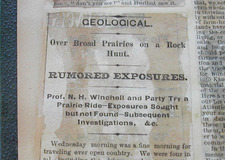Last week we shared how the Minnesota Geological and Natural History Survey was first implemented by director Newton Horace Winchell, State Geologist. Winchell’s field notebooks, along with his annual reports of the survey, provide great insight in to the State Geologist’s activities and the methods that he employed in his work. But these aren’t the only resources that elaborate upon Winchell’s early explorations…
The Newton Horace Winchell papers contain a scrapbook that is filled with newspaper clippings of early articles about the Survey. Articles appear from the Minneapolis Tribune, the St. Paul Dispatch, and St. Paul Pioneer, and indicate that “The Geological Explorations” of Winchell were regularly reported. It appears, from reviewing the accumulation of articles, that the publisher of one of these local newspapers hired a reporter to accompany Winchell on his initial examinations of the geology of the state (it is unclear which article is attributed to which newspaper as very few are labeled).
 In an article titled, “Over Broad Prairies on a Rock Hunt,” the reporter conveyed, in a rather light-hearted manner, Winchell’s trip to examine a reported rock exposure somewhere along the Cedar River in southeastern Minnesota. Winchell and his journalist companion set out from Mantorville to Brownsdale along the Cedar River in search of the rumored geological feature.
In an article titled, “Over Broad Prairies on a Rock Hunt,” the reporter conveyed, in a rather light-hearted manner, Winchell’s trip to examine a reported rock exposure somewhere along the Cedar River in southeastern Minnesota. Winchell and his journalist companion set out from Mantorville to Brownsdale along the Cedar River in search of the rumored geological feature.
Though Winchell was unsuccessful in locating the rumored rocks, the reporter was still able to make an observation, one more sociological than geological. By the late 1800’s, southeastern Minnesota – to include the counties of Dodge, Mower, Fillmore, and Houston – had a growing population of Scandinavian immigrants. The presence of Norwegian immigrants in the lower corner of the state was witnessed by the reporter, who described his interaction with the locals in what he described as a “Norsk oasis.”
“We spent several hours in looking for the rumored exposures said to exist, and then concluded to pursue a myth no longer, but to a small house with one boy, a few dogs, and similar signs of life about it, we directed one course thither. The lads face told his Norwegian antecedents, and his tongue could give us but little information farther. John Johnson, or Ole Olson, or Peter Peterson or Erick Erickson, the boy’s father I mean, was absent, and his gentle partner was wont to express herself only in the mother tongue.
Among the various questions asked the boy by each one of us in turn, only those asking the distance and direction to Brownsdale, elicited lucid answer. The latter information was very correctly given by pointing in the proper direction, and his “six mile I guess” in answer to the first, was only 2 or 3 miles short of the fact.
Leaving this Norsk oasis, we started on in considerably traveled road, the signs of civilization increasing as you drove along.”
The reporter’s description of the encounter with the young Norwegians was likely embellished for a laugh, as I’m certain was the jab regarding naming conventions. I would like to believe that most of the individuals that Winchell and the reporter encountered in the Norsk oasis of southeastern Minnesota (where my Norwegian antecedents settled) greeted them with a warm velkommen.